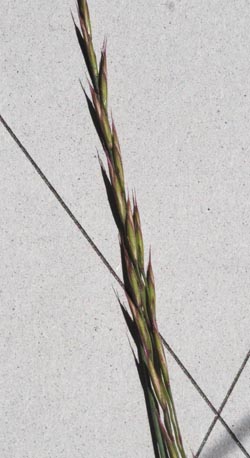Birchleaf Mountain Mahogany

Common Name(s):
Idaho Fescue
Scientific Name:
Festuca idahoensis Elmer
Scientific Name Synonyms:
None known
Symbol:
FEID
Description:
Life Span: Perennial
Origin: Native
Season: Cool
Growth Characteristics: An erect, densely tufted bunchgrass, without rhizomes, growing 1 to 3 feet tall. Starts growth in early spring, seeds mature by midsummer, reproduces from seeds and tillers.
Seedhead: Open, rather narrow panicle, 4 to 7 inches long, with rough, ascending panicle branches; spikelets about ¼ inch long, somewhat flattened, contains 4 to 7 florets; lemmas longer than glumes and has an awn extending from the tip, awns 2/16 to 3/16 inches long.
Leaves: Mostly basal, numerous; blades 5 to 10 inches long, usually not glaucous, fine rolled, somewhat stiff; erect; leaves folded in bud; ligules under 1/16 inch long, collar-shaped, fringed; auricles small or absent.
Ecological Adaptions:
Idaho fescue is a native of the mountains in the northern half of Utah where there is 14 to 24 inches rainfall annually, at elevations from 5,000 to 10,000 feet on all exposures. It may comprise up to 30 percent of the total yield on high mountain sites but less in the lower mountain sites and only a minor constituent in the high water table sites of the mountains. It diminishes in importance from northern Utah south to Sanpete and Sevier Counties. Southward there is an "equivalent" in the form of Arizona fescue. It tends to decrease with heavy use by livestock and is highly susceptible to fire damage because of it's growth characteristics.
Soils: Grows mostly on silt loams, also found on fine sandy or clay loams and loamy sands, where there is good drainage and the soil reaction is neutral to slightly alkaline.
Associated Species: Mountain brome, Richardson's geranium, Columbia needlegrass, bluebunch wheatgrass, and aspen. It differs from sheep fescue, having longer leaves and longer awns, and occuring at lower elevations.
Uses and Management:
Idaho fescue is excellent forage for livestock and wildlife, especially important late in the growing season because it provides green feed longer than the associated species. It is not readily grazed after drying. It is considered to be a key species for management orientation in high mountain sites. A full growing season of rest as needed is a good practice. Special care should be taken not to graze it for a year following burns. Graze only 45 percent of the annual growth.

